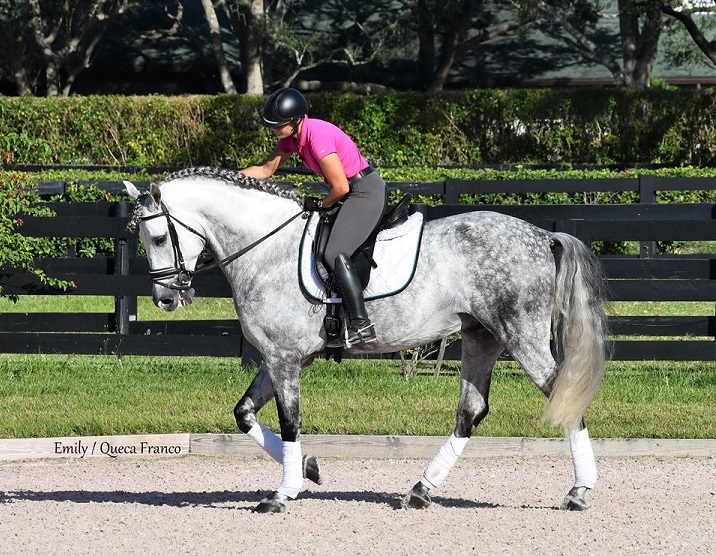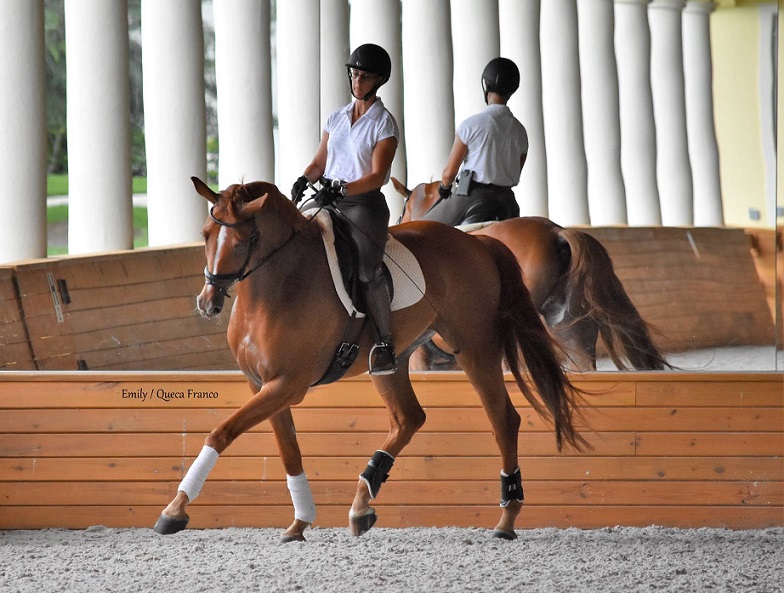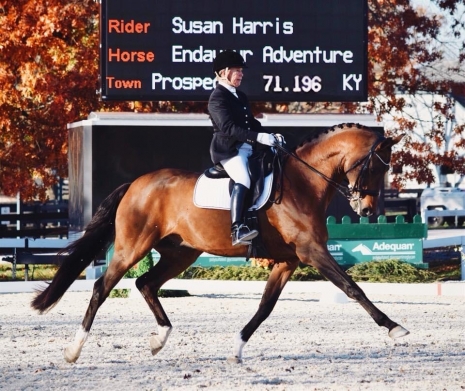By Sue Weakley with Carmen Franco
Start at the Very Beginning
Carmen Franco is a whiz at starting young horses. The Colombian trainer makes her full-time home in South Florida and is based out of May Faire Oaks Farm in Loxahatchee, where she is known for bringing horses up correctly. Read on as she shares some tried-and-true tips to starting a young horse.

When to Start
Franco usually likes to start horses at the end of their third year or sometime between their third and fourth year.
“The training starts on the ground so that the horse understands how to walk with you and interact with you,” she said. “Some people like to call it natural horsemanship; I just call it being a horseman. It’s the horse understanding that they need to respect my space and that the horse needs to depend on me. Sometimes I hand walk them outside the farm before they are able to carry a rider so that they know there is an outside world.”
Then, when the horse demonstrates the basics of good manners, it’s on to the lunge line, where Franco introduces the concept of transitions.
“I do three days a week lunging and that’s it on a 3-year-old horse,” she said. “Then, on a 4-year-old, I go up to four or five times a week. I usually use side-reins on the horses to introduce them to having a frame and a connection. The side-reins are set as long as the neck is at the beginning, not putting any shape to it. The horse needs to get used to feeling something in the mouth and understanding the pressure to the bit. As the training progresses, the reins can be adjusted in length. Sometimes I use a cavesson, sometimes I connect the lunge line to the bit (sliding from inside ring through poll to outside ring)
I introduce the idea that they should move away from the touch of my hand or the touch of the whip, if needed. I introduce a bit of flexion on both sides. Some horses from the beginning are easier on one side than the other so you try to make their bodies more even because, in the long-term, their soundness is going to be compromised if they remain stiff to one side. To help with this, you create more bending, smaller circles and bigger circles to make the stiff side more flexible. Smaller circles create more bending in the body, but they should be used carefully since they can create strain in the joints/tendons/ligaments of young horses. And transitions, transitions, transitions.
All of those concepts are in place before her partner in the process, Melissa Wanstreet, actually gets on the horse. Franco said that it’s a good partnership with mutual trust. Wanstreet has good hands and she trusts Franco’s use of the lunge line when she first mounts the horse.
“Melissa understands how the horse is to go forward,” Franco said. “She’s very brave. That’s why I have her, because I am not.”
“Of course, nothing is perfect ever,” Franco continued. “So, we have to get the rider on at some point even if the horse is not completely even and doesn’t always understand. Then, the rider needs to do the rest.”
Franco starts the backing in the confined space of the round pen so the horse has limits. Once Wanstreet and the horse walk, trot and canter off the lunge line and on their own in the round pen, they move on to the arena.
“Most of the time, you would love to be moving from the round pen to the ring in 60 days, but the horses will tell you when they are ready,” Franco said. “Some horses are ready sooner while some horses at 90 days are still afraid and very unpredictable.”
“Once in the arena, we do some work on the lunge line and then I let her loose. She walks around and then trots around and then one day she canters around. From then on, we are working on the balance and the stamina and the understanding of how to go forward, how to halt, how to accept the weight of the rider. You start applying more geometry lines, make more changes of direction and start making them comfortable in leg-yielding and shoulder-fore.”

The Training Scale
From there, it’s all about the training scale.
“My whole theory on bringing up young horses is you apply the training scale from the beginning,” she said. “First, you have to have a horse that has rhythm and he needs to be willing to cooperate. I think horses have to be happy working for you and not just obey. They need to be willing to make a partnership.”
“Next comes contact and connection, which is not having a Grand Prix frame from the beginning, but they must come through the back to a connection through the hands of the rider. And then, they have to get some impulsion, some straightness and some collection. Even though we don’t talk collection on a young horse, we do start at the beginning by letting them understand that their hind legs have to go under their bodies and not outside their bodies. That’s our way to get them stronger in the back and, at some point, get them light in the front.”
Each Horse is Unique
Franco is firm in her stance that every horse is an individual and it’s important to keep that in mind throughout the process.
“Some horses are more talented than others,” she cautioned. “Some horses have an easier time finding the rhythm in walk/trot/canter. Some have a better balance. Some have more sensitivity in their mouths so you need to be careful what bits you use in the beginning.”
Carmen always starts with the mildest bits available and gauges the horses’ response from there.
“The trick to remember is there is never a straight line up to your goal,” she said. “There are always ups and downs and so many conditions of our horses’ well-being and our introduction to the work with them. There are always issues.”
Franco said the key to understanding the individuality of each horse is honesty with yourself and being willing to back off.
“Sometimes it’s take a step forward and three steps back,” she said. “Maybe you need to put side-reins on the horse, maybe they are in a growing stage and their balance is compromised or the saddle doesn’t fit. Often when a horse changes shape, the connection goes completely wrong. Sometimes a horse is a bit too easy and we push him too much and we have to back off a little bit because the horse is getting a little sour. Maybe some horses are more complicated from the beginning and they have trouble understanding that there’s someone else in command and you have to find different ways to get through. The important thing is that you are honest with yourself and with the horse.”
Growing Pains
She believes that about 85 percent of the changing conditions of the young horse are due to their growing stage.
“They have growing pains whether it’s their teeth, their joints or their muscles,” she explained.
She is careful to work the horses to their level at the moment without pushing them too far mentally or physically and often adds in cavaletti work or other changes in the routine.
“I think a young horse should never work more than four days a week and that should be combined with turn-out time.”
One of the Crowd
Another important element is introducing the horse to other horses while under saddle. Franco said that May Faire Oaks is populated with educated people who know how to deal with young horses in the arena and they kindly steer clear the first time a young horse is in the ring. Later, another professional rider on a seasoned horse joins Franco and the young horse in the arena so the youngster can get comfortable going with another horse in the arena.
“We do small trail rides with horses we know are well-behaved,” she said. “I also like to expose a horse to a situation before they compete or participate in a clinic, I take them to a show and school them there so they have a nice introduction to their competition life.
“Even though the training scale is my bible, you have to be open-minded that every horse is different. From the movements to the sensitivity to the temperament, you have to play around with what’s most important to develop at the time.”
Franco knows that consistency is key when it comes to training a young horse.
“I believe that if I allow one thing that day, the behavior will be there the rest of their lives,” she said. “If you are true to the training scale within the possibilities of playing with it, you will have created a very good horse that has very good basics.”






 Latest Horses for Sale and Lease
Latest Horses for Sale and Lease
